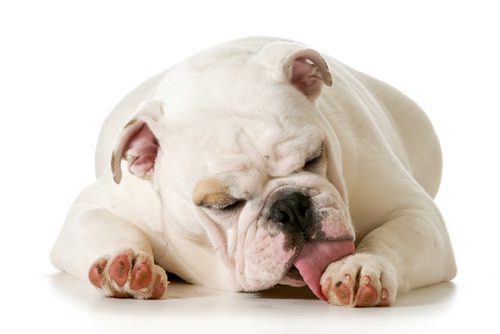When your dog seems to be excessively licking or biting their paws, it might be more than just a habit. A dog yeast infection on the paw is a common issue that can lead to discomfort and irritation for your pet. Knowing the symptoms and understanding the treatment options is essential to help your dog find relief and regain their comfort. In this blog, we’ll explore what a yeast infection on a dog’s paw looks like, the common causes, and the best ways to address it.

Understanding Yeast Infections in Dogs’ Paws
Yeast infections in dogs are caused by an overgrowth of a fungus called Malassezia, which is naturally present on their skin. While this fungus is typically harmless, certain conditions can lead to an overgrowth, causing an infection. The paws are particularly vulnerable because they often encounter moist and warm environments, ideal for yeast to thrive.
Causes of Yeast Infections on Paws
Several factors can contribute to a yeast infection on a dog’s paw:
- Moisture Exposure: Dogs often walk through water or damp grass, creating the perfect environment for yeast to multiply.
- Allergies: Environmental or food allergies can weaken the skin’s defenses, allowing yeast to grow unchecked.
- Underlying Health Issues: Conditions such as hypothyroidism or immune deficiencies may increase susceptibility to yeast infections.
- Poor Grooming: Neglecting regular cleaning of paws can lead to an accumulation of dirt and moisture, encouraging fungal growth.
- Use of Antibiotics: Prolonged use of antibiotics can disrupt the natural balance of bacteria and yeast, leading to overgrowth.
Symptoms of a Dog Paw Pad Yeast Infection
Here are the most common signs to watch for:
- Redness and inflammation
- Constantly licking or biting their paws
- A distinct, musty smell
- Discoloration of fur
- Scaly or crusty skin on the paws
- Limping or favoring a paw
If your dog is displaying any combination of these symptoms, contact Mills Animal Hospital to schedule an examination.
Diagnosing a Yeast Infection on a Dog’s Paw
Veterinarians use several methods to confirm a yeast infection on your dog’s paw:
- Physical Examination: A thorough visual inspection of the paw can reveal redness, swelling, and other visible signs of infection.
- Skin Scraping or Swabs: Samples collected from the affected area can be analyzed under a microscope to detect yeast overgrowth.
- Medical History Review: Understanding your dog’s recent health history, including allergies or antibiotic use, can help pinpoint contributing factors.
How Is a Dog Yeast Infection on Paw Treated?
Addressing a yeast infection on your dog’s paw typically involves a combination of veterinary-prescribed treatments and preventative measures to reduce recurrence.
Topical Treatments
- Antifungal Creams and Ointments: These medications are applied directly to the affected paw to eliminate yeast growth.
- Medicated Shampoos: Regular baths with antifungal shampoos can help treat the infection and maintain paw hygiene.
- Paw Soaks: Soaking the affected paw in a veterinarian-recommended solution can soothe irritation and cleanse the area.
Oral Medications
In severe cases, your veterinarian may prescribe oral antifungal medications to tackle the infection from within. These medications are typically used for persistent or widespread yeast infections.
Dietary Adjustments
If food allergies are suspected as a contributing factor, your veterinarian might recommend a hypoallergenic diet to minimize triggers. Probiotics can also help restore the natural balance of bacteria and yeast in your dog’s system.
How to Protect Your Dog From Yeast Infections
- Wiping your dog’s paws after walks, especially in damp conditions, helps prevent moisture buildup.
- Trimming excess fur around the paws reduces areas where moisture and dirt can accumulate.
- Managing environmental or food allergies can reduce the likelihood of yeast infections.
- Always consult your veterinarian before beginning any treatment plan to ensure it’s safe and appropriate for your pet’s specific condition.
When Should You Contact Your Veterinarian?
While minor yeast infections may seem manageable, seeking veterinary care is essential to ensure the issue doesn’t worsen. You should call Mills Animal Hospital if the symptoms persist or worsen, your dog shows signs of pain, multiple paws or other body areas are affected, or if your dog has a history of recurring infections. Prompt professional care helps prevent complications and ensures your dog’s comfort and well-being.
Maintaining Healthy Paws Year-Round
Preventing yeast infections on your dog’s paws requires consistent care and attention. Regularly cleaning your dog’s paws, especially after exposure to wet or muddy conditions, is a simple yet effective step. Ensuring your dog’s diet supports a healthy immune system can also reduce the risk of infections. Finally, scheduling regular check-ups with Mills Animal Hospital keeps your pet’s health on track and addresses potential issues early. Your dog’s paws are essential to their daily life, and keeping them healthy helps your pet stay active and happy. If you notice signs of a yeast infection, don’t wait. Contact Mills Animal Hospital to schedule an appointment and get your pet the care they need.
